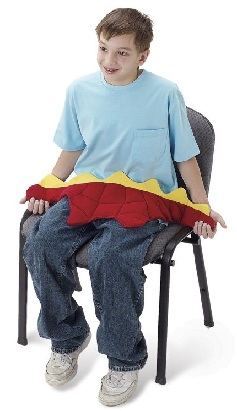Sensory Processing Disorder (SPD) is often associated with a large number of different neurological, psychiatric, behavioral, and learning disorders. Formerly referred to as sensory integration dysfunction, SPD is a neurological disorder that impairs the brain's ability to absorb, process, and react appropriately to tactile, auditory, visual, olfactory and gustatory stimuli coming from one's own body via nerve endings and the environment. The five senses send sensory messages to the brain, but vestibular and proprioceptive senses are vital to the process as well. The vestibular system is the connection that coordinates balance with movement and even takes gravity and head position into account for more efficient and graceful movement. Balance is a prerequisite for movement. The proprioceptive sense is the "position sense," and is an internal body communication that utilizes information from joints, ligaments, tendons, and muscles. Equilibrium is part of posture, and is defined as a sense of being able to maintain bodily balance and establish a mental state of calmness and composure, because the person feels in control.
This integrated processing results in perception, and the ability to synthesize this information is critical for people to interact efficiently with the environment. Basically, the 'gravitational insecurity' of individuals with SPD is a direct result of poor processing of vestibular and proprioceptive stimuli and causes acute anxiety, fear or panic. Other processing disorders such as autism, ADD, and ADHD share some of these same characteristics of SPD: difficulty while trying to process and respond to a constant barrage of information that ends up being received or processed differently in the brain, often resulting in unusual reactions. The medical community has made great leaps and bounds in properly diagnosing and more effectively treating SPD and other processing disorders in the last ten years.
Sensory integration (SI) therapy is a common therapy that utilizes weighted vests, belts and blankets for children and adults with SPD, cerebral palsy, autism, muscular dystrophy, pervasive development disorder and other processing disabilities. The theory is that behavioral and processing problems are due to improper sensitivity to sensory input. Weighted cloth provides proprioceptive feedback and encourages a sense of stability which has a calming effect. The pressure provided by the weighted clothing relaxes the body and calms down the central nervous system, allowing the person to better integrate sensory information. The results are undeniable, as children and adults using SI are more organized and can concentrate better on the task at hand. Weighted clothing and products are instrumental tools to help facilitate behavioral changes and enhanced processing of information.
The
Weighted Wonder Vest has quickly removable weight pouches to provide the perfect amount of sensory stimulation at all times. The vest not only works during therapy, but also while at home or out for visits to the doctor, grocery store, during the car ride there; the possibilities are endless. It is available in both child and adult sizes with the appropriately stylish look; ABCfs for the children and solid and plaid prints for the adults.
The Weighted Cozy Comforter is another great option for children and adults, and provides full body pressure for the maximum in processing ability. It facilitates better sleep and provides calming pressure whether at the doctor or just in the car. The Cozy Comforter works with the position sense through body awareness and the tactile sense. The weights are evenly distributed around the body and define physical boundaries, so the comforter actually aids the vestibular system by providing the connection between balance, movement and gravity.

The Tumble Forms Weghted Critters allows the bodies of children to delay their thought process through added weight. This process allows the time needed to make logical sense of a task, activity or movement. It keeps them focused on the activity and in the chair with less self-stimulatory behavior and distraction.
Many children and adults have sensitivity issues to sensory information that impairs learning and creates a threatening situation for the individual, causing increased anxiety and fear combined with a decreased ability to interpret and respond appropriately to something in the immediate environment. If left untreated, behavioral and motor problems may occur and increase in severity. Weighted products are so helpful because they provide the extra sensory input for people with stimulation issues. Sensory stimulus can only be processed if the individual is relaxed, so he or she can function better in todayfs society or family structure. Help these individuals process the information to make purposeful, adaptive responses and to get on with their day-to-day activities by using a weighted product.
Alyssa Aldana,
and
Hulet Smith, OT